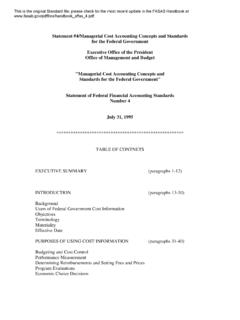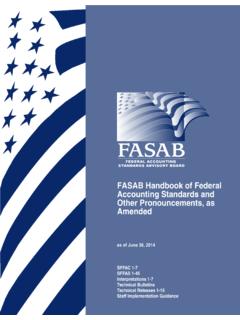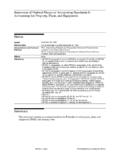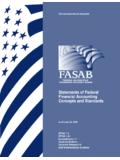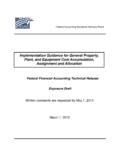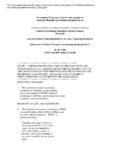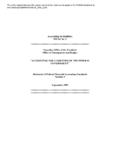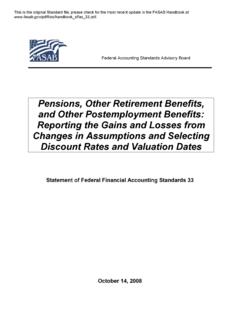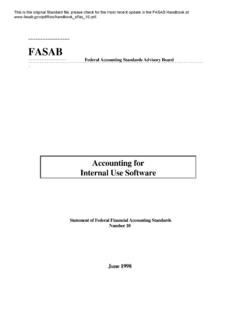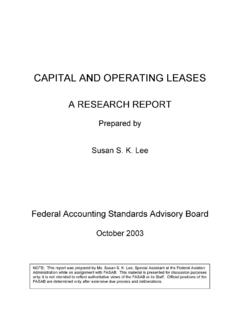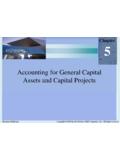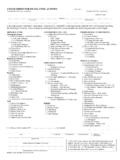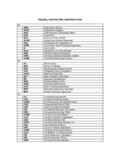Transcription of Statement of Federal Financial Accounting …
1 EXECUTIVE OFFICE OF THE PRESIDENTSTATEMENT OF Federal Financial Accounting CONCEPTS NO. 2 ENTITY AND DISPLAYJUNE 5, 1995[PRINTED COPIES AVAILABLE FROM THE government PRINTINGOFFICE AT 202 512-1800. GPO STOCK NO. 041-001-00456-1 $ ]TABLE OF CONTENTS: PARAGRAPH # for Defining Reporting of the Federal the Reporting Entities forGeneral Purpose Financial for Including Components in a Reporting Aspects Concerning the Completeness of the Financial Content for the Recommended 1-A: Balance SheetAppendix 1-B: Statement of Net CostsAppendix 1-C: Statement of Changes in Net PositionAppendix 1-D: Statement of Custodial ActivitiesAppendix 1-E: Statement of Budgetary ResourcesAppendix 1-F: Statement of Program Performance MeasuresINTRODUCTIONThis is the original Concepts Statement file; please check for the most recent update in the FASAB Handbook at 1 A basic postulate of Accounting is that Accounting information pertains to entities, , circumscribed legal, administrative, fiduciary, or other organizational structures.
2 Another basic postulate is that entities use Financial reports to communicate Financial and related information about the entity to persons concerned with the The purpose of this Statement of Accounting concepts is to provide guidance as to what would be encompassed by a Federal government entity's Financial report. The Statement specifies the types of entities for which there ought to be Financial reports (hereinafter called reporting entities), establishes guidelines for defining the makeup of each type of reporting entity, identifies types of Financial reports for communicating the information for each type of reporting entity, and suggests the types of information each type of report would A Statement of Financial Accounting concepts is intended to guide the members of the Federal Accounting Standards Advisory Board (FASAB) as they deliberate and recommend Accounting standards for the Federal government .
3 It also would be useful to the Office of Management and Budget (OMB), when it carries out its statutory responsibilities for specifying who should prepare Financial statements and the form and content of those statements;[note 1] and as broad guidance for preparers, auditors, and users of Financial statements of Federal agencies. A Statement of Financial Accounting concepts does not, in and of itself, represent standards that would be considered generally accepted Accounting principles for Federal agencies to be followed for the preparation of Financial statements. [NOTE 1: OMB specifies the form and content of agency and governmentwide Financial statements, pursuant to authority assigned in the Chief Financial Officers Act of 1990, as amended (title 31, U. S. Code, section 3515(d) and section 331 (e) (1)) through periodic issuance of OMB Bulletins.]
4 OMB intends to base the form and content on the concepts contained in this Statement . ]4 This Statement does not try to define which reporting entities must prepare and issue Financial statements. That authority and responsibility resides with the Congress, OMB, and other oversight organizations and resource The specification of reporting entities intends to be suitable for allThis is the original Concepts Statement file; please check for the most recent update in the FASAB Handbook at organizations within the Executive branch of the Federal government , including the Departments, independent agencies, [NOTE 2] commissions, and corporations. FASAB does not propose to recommend Accounting concepts and standards for the Legislative and Judicial branches. However, the concepts recommended in this Statement would be appropriate for those branches.
5 [NOTE 2:"Independent agencies" is a term used to distinguish agencies that are independent of a Cabinet department from the agencies that are part of the Cabinet departments. Independent agencies report directly to the President and are part of the U. S. government .]6 The concepts, as defined in this Statement , are intended primarily for the general purpose Financial reporting performed by Federal entities. This is the Financial reporting that these entities would undertake to help meet the objectives defined in Statement of Federal Financial Accounting Concepts (SFFAC) No. 1, "Objectives of Federal Financial Reporting." These objectives are as follows: Budgetary integrity. Federal Financial reporting should assist in fulfilling the government 's duty to be publicly accountable for monies raised through taxes and other means and for their expenditure in accordance with the appropriations laws that establish the government 's budget for a particular fiscal year and related laws and regulations.
6 Operating performance. Federal Financial reporting should assist report users in evaluating the service efforts, costs, and accomplishments of the reporting entity; the manner in which these efforts and accomplishments have been financed; and the management of the entity's assets and liabilities. Stewardship. Federal Financial reporting should assist report users in assessing the impact on the country of the government 's operations and investments for the period and how, as a result, the government 's and the nation's Financial conditions have changed and may change in the future. Systems and control. Federal Financial reporting should assist report users in understanding whether Financial management systems and internal Accounting and administrative controls are adequate to ensure proper execution of transactions, safeguard assets, and support performance is the original Concepts Statement file.
7 Please check for the most recent update in the FASAB Handbook at 7 The concepts are also intended, as FASAB's mission Statement requires, to help in meeting the Financial and budgetary information needs of executive agencies and Congressional oversight groups, and to strengthen the conceptual basis and consistency of Federal Accounting The entity and display concepts presented in this Statement do not preclude the specification of ad hoc or temporary reporting entities to meet special reporting needs of users of Federal agencies' Financial information. Nor do they preclude a reporting entity from preparing special purpose Financial reports to meet the specific needs of persons in the reporting entity or in response to requests from persons outside the entity for certain Financial information; or from preparing a so-called "popular report," which provides a simplified, highly readable, easily understandable description of a reporting entity's finances.
8 These statements would not necessarily purport to be presented in accordance with generally accepted Accounting FOR DEFINING REPORTING ENTITIES9 The most basic reason for having an explicit understanding of what the reporting entity entails is to ensure that the users of the entity's Financial reports are provided with all the information that is relevant to the reporting entity, subject to cost and time constraints. Clearly defining the boundaries of the reporting entity provides the users with a clear understanding of what the reporting entity encompasses. It helps to establish what information is relevant to the Financial statements and what information is Other reasons for having an explicit understanding of what the reporting entity entails are to: ensure that for the aggregation of information at each reporting level, no entity is omitted, and to provide for consolidations and/or combinations of information from reporting units at the same level, as appropriate; assist in making comparisons among comparable reporting entities by reducing the possibility of unintended or arbitrary exclusions or inclusions of entities; assist in making comparisons among alternative ways to provide similar services or products;This is the original Concepts Statement file.
9 Please check for the most recent update in the FASAB Handbook at be able to distribute costs properly and fully and to properly attribute the responsibility for assets and liabilities; and facilitate evaluating performance, responsibility, and control, especially where one agency is the provider or recipient of services attributable to or financed by another OF THE Federal GOVERNMENT11 The Federal government is an extremely complex organization composed of many different components. For Accounting and reporting purposes, it may be viewed from at least three perspectives. However, the nature of each type of component and the relationships among the components and perspectives are not always Perspective12 The first type of perspective is the organization perspective. The Federal government is composed of organizations that manage resources and are responsible for operations, , delivering services.
10 These include the major Departments and independent agencies, which are generally divided into suborganizations, , smaller organizational units with a wide variety of titles, including bureaus, administrations, agencies, services, and corporations. Many of these are further divided into even smaller suborganizations. On the other hand, there are small agencies for which division into smaller units is generally not considered Perspective13 From another perspective, the government is composed of accounts presented in the budget, hereinafter referred to as budget accounts. Budget accounts are composed of expenditure (appropriations or fund) accounts and receipt (including offsetting receipt) accounts. The size and scope of these accounts varies according to Congressional preference. They can vary from very small accounts, which are useful for constraining management, to very large accounts, which can be used to finance many is the original Concepts Statement file; please check for the most recent update in the FASAB Handbook at 14 Budget accounts are not the same as Treasury accounts.
